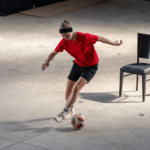“It Was Just A Regular MRI”: Judith’s Story

Recently we’ve been talking a lot about MRIs and cochlear implants but what if you have a BONEBRIDGE or a VIBRANT SOUNDBRIDGE? Well you’ll be pleased to hear that having an MRI with either of these hearing implants is pain-free, hassle-free, and very easy to do. In fact, according to SOUNDBRIDGE user Judith, it feels exactly the same as having an MRI without an implant!
MRI With BONEBRIDGE and SOUNDBRIDGE
But first, a few hard facts. In most countries, if you have a BONEBRIDGE you can undergo MRIs of up to 1.5 Tesla, which is the most common type of MRI. If you have the latest generation of SOUNDBRIDGE, known as the VORP503, you can also have 1.5 Tesla MRIs.
How is this possible? Because your BONEBRIDGE or SOUNDBRIDGE implant doesn’t have just one magnet inside, but several force-balanced magnets. When the powerful magnetic forces in the MRI machine pull on one of the magnets, the other magnets pull in the opposite direction and cancel out the force. This means that there is no force or pressure on your implant. And this gives you a pain-free MRI experience.
With some implants you might have to wear a tightly-wrapped head bandage while you have your scan, but not with MED-EL. BONEBRIDGE and SOUNDBRIDGE are designed so that the radiologist doesn’t have to waste time wrapping a bandage around your head. The only thing you have to do before your scan is to take off your audio processor, along with your jewelry, watch, and any other metal items.
But My Radiologist Said No!
Having MRIs with hearing implants has only been possible for the last few years. Sometimes doctors and radiologists aren’t always aware of the latest developments in hearing implant technology, and so aren’t sure if an MRI is possible with your particular implant.
If your doctor or radiologist says you can’t have an MRI with your hearing implant, there are several things you can do. First, you can show them your implant’s identification card, where it states that an MRI is possible. You can also download the Important Safety Information for your country, so that they can see what is possible with your implant. And of course, you can always contact your local MED-EL office, who may be able to talk to your radiologist, and go through their concerns.
Judith’s MRI Story
Judith lost her hearing as an adult and was overjoyed to be able to hear again with SOUNDBRIDGE. Due to an accident, Judith had to have regular MRI scans before getting her implant, and still needs them now she has her implant. She told us all about having an MRI with SOUNDBRIDGE, plus a little about what life is like with a middle ear implant.
I was diagnosed with otosclerosis around the age of 40, which is a problem in my father’s family—around the age of 40 everyone goes deaf. I consulted a surgeon who originally told me to have stapes surgery which I did on my left ear, and I also eventually did on my right ear. But that wasn’t enough. That’s how I ended up with SOUNDBRIDGE on my right ear. My life changed with the SOUNDBRIDGE because it has become more predictable. I’m not afraid of losing my hearing aid anymore.
I had a motorcycle accident several years ago. I had neck surgery for that. The surgeon told me then that it would need to be checked every four or five years, preferably by MRI. So I was really excited when I found out that a new SOUNDBRIDGE model was coming out, that would allow MRIs.
There were no special preparations necessary for my MRI. They didn’t give me any painkillers before my MRI, because MRIs aren’t painful. It’s not necessary at all. The MRI procedure was really simple. I had to take the SAMBA off, they put me in the tube they did the MRI and I came back out. That was it. It took about 15 minutes for my particular kind of MRI. I’ve had MRIs before and I couldn’t tell any difference. I didn’t feel anything at all. Nothing unusual, no, nothing. It was just a regular MRI.
Thanks Judith!
Want to know more life with SOUNDBRIDGE? Meet Patricia and find out how SOUNDBRIDGE changed her life.
Find out more about how BONEBRIDGE and SOUNDBRIDGE work and how they could help you or your child.
Thanks for your message. We will reply as soon as possible.
Send us a message
Field is required
John Doe
Field is required
name@mail.com
Field is required
What do you think?


